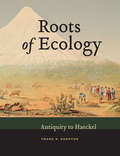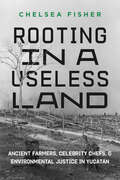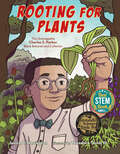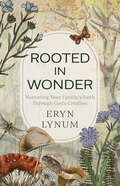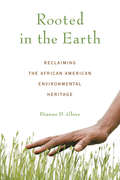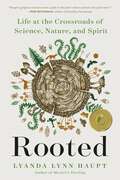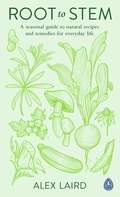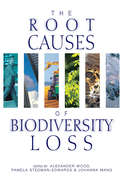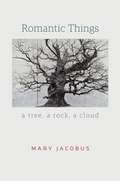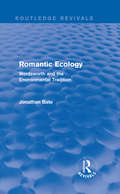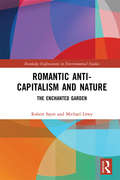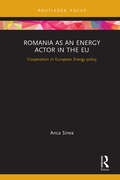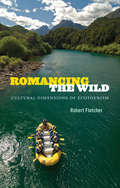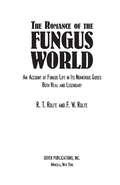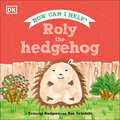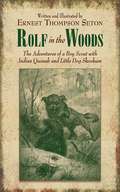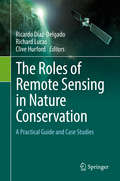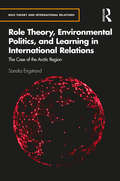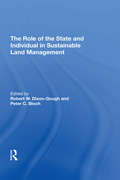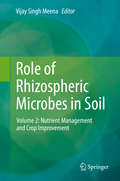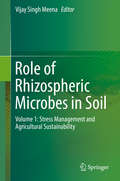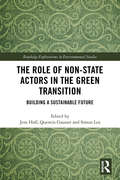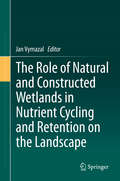- Table View
- List View
Roots of Ecology
by Frank N. EgertonEcology is the centerpiece of many of the most important decisions that face humanity. Roots of Ecology documents the deep ancestry of this now enormously important science from the early ideas of Herodotos, Plato, and Pliny, up through those of Linnaeus and Darwin, to those that inspired Ernst Haeckel's mid-nineteenth-century neologism ecology. Based on a long-running series of regularly published columns, this important work gathers a vast literature illustrating the development of ecological and environmental concepts, ideas, and creative thought that has led to our modern view of ecology. Roots of Ecology should be on every ecologist's shelf.
Rooting in a Useless Land: Ancient Farmers, Celebrity Chefs, and Environmental Justice in Yucatan
by Chelsea FisherIn Rooting in a Useless Land, Chelsea Fisher examines the deep histories of environmental-justice conflicts in Mexico's Yucatán Peninsula. She draws on her innovative archaeological research in Yaxunah, an Indigenous Maya farming community dealing with land dispossession, but with a surprising twist: Yaxunah happens to be entangled with prestigious sustainable-development projects initiated by some of the most famous chefs in the world. Fisher contends that these sustainable-development initiatives inadvertently bolster the useless-land narrative—a colonial belief that Maya forests are empty wastelands—which has been driving Indigenous land dispossession and environmental injustice for centuries. Rooting in a Useless Land explores how archaeology, practiced within communities, can restore history and strengthen relationships built on contested ground.
Rooting for Plants: The Unstoppable Charles S. Parker, Black Botanist and Collector
by Janice N. HarringtonMeet Charles S. Parker, an unsung yet trailblazing Black scientist who made major contributions to the fields of botany (the study of plants) and mycology (the study of fungi) in this inspiring STEM/STEAM picture book biography.In 1882, Black botanist and mycologist Charles S. Parker sprouted up in the lush, green Pacific Northwest. From the beginning, Charles&’s passion was plants, and he trudged through forests, climbed mountains, and waded into lakes to find them. When he was drafted to fight in World War I, Charles experienced prejudice against Black soldiers and witnessed the massive ecological devastation that war caused. Those experiences made him even more determined to follow his dreams, whatever the difficulties, and to have a career making things grow, not destroying them.As a botanist and teacher, Charles traveled the United States, searching for new species of plants and fungi. After discovering the source of the disease killing peach and apricot trees, Charles was offered a job at Howard University, the famed historically Black college where he taught the next generation of Black scientists—men and women—to love plants and fungi as much as he did.
Rooted in Wonder: Nurturing Your Family's Faith Through God's Creation
by Eryn LynumMasterfully connects Scripture to nature and nature to God.--Lori Wildenberg, national speaker, parent coach, and authorFor a generation whose eyes are constantly trained on screens, encountering nature at all is increasingly difficult, much less seeing what it reveals about God. How can parents help children reengage with God's world that is full of amazement, creativity, and love?Eryn Lynum is a certified master naturalist, Bible teacher, and mom of four who wants to help families encounter and understand the connection between God and creation. She shares her own story of putting her kids in front of nature, and invites other parents to consider a similar journey.With practical sections that look at nature through the lens of the Bible and activities to integrate faith and the natural world, Rooted in Wonder helps parents instill within their kids an unshakable faith. Through the art of play, the drive of discovery, and the awe of adventure, children will gain a sense of wonder in their Creator that will last a lifetime."With joy and practical know-how, Eryn Lynum helps parents connect the beauty of creation with love for the Creator. Rooted in Wonder is a must-read for helping the next generation to get outdoors and get to know God."--Matthew Sleeth, MD, executive director of Blessed Earth
Rooted in the Earth: Reclaiming the African American Environmental Heritage
by Dianne GlaveWith a basis in environmental history, this groundbreaking study challenges the idea that a meaningful attachment to nature and the outdoors is contrary to the black experience. The discussion shows that contemporary African American culture is usually seen as an urban culture, one that arose out of the Great Migration and has contributed to international trends in fashion, music, and the arts ever since. But because of this urban focus, many African Americans are not at peace with their rich but tangled agrarian legacy. On one hand, the book shows, nature and violence are connected in black memory, especially in disturbing images such as slave ships on the ocean, exhaustion in the fields, dogs in the woods, and dead bodies hanging from trees. In contrast, though, there is also a competing tradition of African American stewardship of the land that should be better known. Emphasizing the tradition of black environmentalism and using storytelling techniques to dramatize the work of black naturalists, this account corrects the record and urges interested urban dwellers to get back to the land.
Rooted: Life at the Crossroads of Science, Nature, and Spirit
by Lyanda Lynn HauptDeepen your connection to the natural world with this inspiring meditation, "a path to the place where science and spirit meet" (Robin Wall Kimmerer).In Rooted, cutting-edge science supports a truth that poets, artists, mystics, and earth-based cultures across the world have proclaimed over millennia: life on this planet is radically interconnected. Our bodies, thoughts, minds, and spirits are affected by the whole of nature, and they affect this whole in return. In this time of crisis, how can we best live upon our imperiled, beloved earth?Award-winning writer Lyanda Lynn Haupt&’s highly personal new book is a brilliant invitation to live with the earth in both simple and profound ways—from walking barefoot in the woods and reimagining our relationship with animals and trees, to examining the very language we use to describe and think about nature. She invokes rootedness as a way of being in concert with the wilderness—and wildness—that sustains humans and all of life.In the tradition of Rachel Carson, Elizabeth Kolbert, and Mary Oliver, Haupt writes with urgency and grace, reminding us that at the crossroads of science, nature, and spirit we find true hope. Each chapter provides tools for bringing our unique gifts to the fore and transforming our sense of belonging within the magic and wonder of the natural world.
Root to Stem: A seasonal guide to natural recipes and remedies for everyday life
by Alex Laird'Root to Stem is a seasonal and holistic approach to health that puts plants, herbs and nature at the heart of how we live and eat. It is a new kind of guide that links individual health to our communities and the planet's health to sustain us all.'This perfect companion to the seasons, this book will show you how to take greater control over your own health and well-being, treat everyday ailments, and ensure the sustainability of the planet through discovering how to forage, grow, or shop for plant- and herb-based foods and products. Including: Detox in the spring with sorrel, cleavers and nettles. Harvest summer lime leaf shoots to soothe digestive upsets and feed gut microbes. Bake a Lammas loaf to celebrate the autumnal equinox. Boost your winter immunity with red berries, purple potatoes and rosehips. Root-to-stem eating encourages you to use every edible part of plant, including the leaves, skin, seeds and stalks.Travelling through the four seasons, expert medical herbalist Alex Laird shares the natural ingredients that are available on your doorstep, simple delicious recipes and easy-to-make herbal remedies.
The Root Causes of Biodiversity Loss
by Alexander Wood Pamela Stedman-Edwards Johanna MangThe world is losing species and biodiversity at an unprecedented rate. The causes go deep and the losses are driven by a complex array of social, economic, political and biological factors at different levels. Immediate causes such as over-harvesting, pollution and habitat change have been well studied, but the socioeconomic factors driving people to degrade their environment are less well understood. This book examines the underlying causes. It provides analyses of a range of case studies from Brazil, Cameroon, China, Danube River Basin, India, Mexico, Pakistan, Philippines, Tanzania and Vietnam, and integrates them into a new and interdisciplinary framework for understanding what is happening. From these results, the editors are able to derive policy conclusions and recommendations for operational and institutional approaches to address the root causes and reverse the current trends. It makes a contribution to the understanding of all those - from ecologists and conservationists to economists and policy makers - working on one of the major challenges we face.
Rome
by Rabun Taylor Rinne Katherine Wentworth Spiro KostofSpanning the entire history of the city of Rome from Iron Age village to modern metropolis, this is the first book to take the long view of the Eternal City as an urban organism. Three thousand years old and counting, Rome has thrived almost from the start on self-reference, supplementing the everyday concerns of urban management and planning by projecting its own past onto the city of the moment. This is a study of the urban processes by which Rome's people and leaders, both as custodians of its illustrious past and as agents of its expansive power, have shaped and conditioned its urban fabric by manipulating geography and organizing space; planning infrastructure; designing and presiding over mythmaking, ritual, and stagecraft; controlling resident and transient populations; and exploiting Rome's standing as a seat of global power and a religious capital.
Romantic Things: a tree, a rock, a cloud
by Mary JacobusOur thoughts are shaped as much by what things make of us as by what we make of them. Lyric poetry is especially concerned with things and their relationship to thought, sense, and understanding. In Romantic Things, Mary Jacobus explores the world of objects and phenomena in nature as expressed in Romantic poetry alongside the theme of sentience and sensory deprivation in literature and art. Jacobus discusses objects and attributes that test our perceptions and preoccupy both Romantic poetry and modern philosophy. John Clare, John Constable, Rainer Maria Rilke, W. G. Sebald, and Gerhard Richter make appearances around the central figure of William Wordsworth as Jacobus explores trees, rocks, clouds, breath, sleep, deafness, and blindness in their work. While she thinks through these things, she is assisted by the writings of Maurice Merleau-Ponty, Jacques Derrida, and Jean-Luc Nancy. Helping us think more deeply about things that are at once visible and invisible, seen and unseen, felt and unfeeling, Romantic Things opens our eyes to what has been previously overlooked in lyric and Romantic poetry.
Romantic Ecology: Wordsworth and the Environmental Tradition (Routledge Revivals)
by Jonathan BateFirst published in 1991, Romantic Ecology reassesses the poetry of William Wordsworth in the context of the abiding pastoral tradition in English Literature. Jonathan Bate explores the politics of poetry and argues that contrary to critics who suggest that the Wordsworth was a reactionary who failed to represent the harsh economic reality of his native Lake District, the poet’s politics were fundamentally ‘green’. As our first truly ecological poet, Wordsworth articulated a powerful and enduring vision of human integration with nature which exercised a formative influence on later conservation movements and is of immediate relevance to great environmental issues today. Challenging the orthodoxies of new historicist criticism, Jonathan Bate sets a new agenda for the study of Romanticism in the 1990s.
Romantic Anti-capitalism and Nature: The Enchanted Garden (Routledge Explorations in Environmental Studies)
by Robert Sayre Michael LöwyRomantic Anti-capitalism and Nature examines the deep connections between the romantic rebellion against modernity and ecological concern with modern threats to nature. The chapters deal with expressions of romantic culture from a wide variety of different areas: travel writing, painting, utopian vision, cultural studies, political philosophy, and activist socio-political writing. The authors discuss a highly diverse group of figures - William Bartram, Thomas Cole, William Morris, Walter Benjamin, Raymond Williams, and Naomi Klein - from the late eighteenth to the early twenty-first century. They are rooted individually in English, American, and German cultures, but share a common perspective: the romantic protest against modern bourgeois civilisation and its destruction of the natural environment. Although a rich ecocritical literature has developed since the 1990s, particularly in the United States and Britain, that addresses many aspects of ecology and its intersection with romanticism, they almost exclusively focus on literature, and define romanticism as a limited literary period of the late eighteenth and early nineteenth centuries. This study is one of the first to suggest a much broader view of the romantic relation to ecological discourse and representation, covering a range of cultural creations and viewing romanticism as a cultural critique, or protest against capitalist-industrialist modernity in the name of past, pre-modern, or pre-capitalist values. This book will be of great interest to students and scholars of ecology, romanticism, and the history of capitalism.
Romania as an Energy Actor in the EU: Cooperation in European Energy policy (Europa Perspectives on the EU Single Market)
by Anca SineaThe purpose of this book is twofold. First, it aims to explain the general framework for cooperation in the energy sector in Europe, with a conceptual basis that allows for a better understanding of the dynamics that led to its existence. Second, the volume deals with Romania both as a representative case for the region, given the commonalities raised by the transition process in the last three decades, and also as a country with a specific energy agenda, with implications for internal and foreign policy that can only be perceived and understood in the Romanian context.
Romancing the Wild: Cultural Dimensions of Ecotourism
by Robert FletcherThe worldwide development of ecotourism—including adventures such as mountain climbing and whitewater rafting, as well as more pedestrian pursuits such as birdwatching—has been extensively studied, but until now little attention has been paid to why vacationers choose to take part in what are often physically and emotionally strenuous endeavors. Drawing on ethnographic research and his own experiences working as an ecotour guide throughout the United States and Latin America, Robert Fletcher argues that participation in rigorous outdoor activities resonates with the particular cultural values of the white, upper-middle-class Westerners who are the majority of ecotourists. Navigating 13,000-foot mountain peaks or treacherous river rapids demands deferral of gratification, perseverance through suffering, and a willingness to assume risks in pursuit of continuous progress. In this way, characteristics originally cultivated for professional success have been transferred to the leisure realm at a moment when traditional avenues for achievement in the public sphere seem largely exhausted. At the same time, ecotourism provides a temporary escape from the ostensible ills of modern society by offering a transcendent "wilderness" experience that contrasts with the indoor, sedentary, mental labor characteristically performed by white-collar workers.
The Romance of the Fungus World: An Account of Fungus Life in Its Numerous Guises Both Real and Legendary
by R. T. RolfeMankind has always had a love-hate relationship with fungi. On the positive side, edible mushrooms and truffles are gastronomic delights, and certain fungi possess medicinal properties. On the other hand, many mushrooms are poisonous, and fungi can inflict costly damage on crops and other property. This captivating book explores both sides of the story, examining aspects usually overlooked in texts and field guides.The survey begins with fungi lore from mythology and legends, focusing particularly on the plants' association with devils, witches, and fairies. A balanced portrait of fungi in the real world considers not only the ruin caused by the plants but also their uses in medicine and industry and as foods. Ranging far and wide in its topics, the narrative offers a light touch and plenty of enthusiasm, making this book fun for everyone with even a casual interest in mushrooms. In addition, serious mushroom hunters will find this volume a practical reference and a fascinating resource for leisurely browsing.
The Romance of the Colorado River
by Frederick S. DellenbaughIn 1871, seventeen-year-old Fred Dellenbaugh walked into a hotel room in Chicago, and with a “You’ll do, Fred,” began a lifetime of danger-fraught exploration. Under the lead of John Wesley Powell, a Civil War hero with only one arm, Fred journeyed into the Grand Canyon and its subsidiary canyons and rivers, with the intention of exploring, mapping, and recording description of the uncharted territory. The men found themselves battling the great force of the Colorado River, with its fatal, quick rapids and mighty waterfalls. Their small, frail boats were no match for the river, and as they began to capsize and as supplies were lost overboard, the expedition quickly became about survival. It was only through the steady command of Major Powell that the team prevailed. They went on to accomplish their mission, which has become historically significant today. <P><P> The Romance of the Colorado River is Dellenbaugh’s personal story, written thirty years after the great adventure. The volume includes twenty of the author’s original illustrations, as well as nearly 150 contemporary photographs, which provide an accurate image of what the explorers encountered during their expedition. Dellenbaugh also recounts previous attempts to explore the valley, by both Europeans and fellow Americans, adding a historical element to the story. Part adventure narrative and part geography survey of the Colorado River, this book offers a unique firsthand account of a fascinating scientific expedition.
Roly the Hedgehog (Roly and Friends)
by Frances RodgersLet your little nature lover learn how to help the adorable animals that like to visit your yard.Meet Roly. She&’s a curious, prickly hedgehog who loves to explore yards, including yours! The yard can often be a dangerous place, and Roly needs your help to face these challenges. Are you in?This illustrated children&’s book about nature is perfect for gently introducing young readers to the idea of animal conservation and protection. It includes: • Beautifully illustrated spreads. • An engaging storyline that kids can follow and relate to, as the book refers to the wildlife that can be found in their own backyard or garden. • Fun-filled facts about hedgehogs. • A thoughtful and timely message about protecting wildlife, with tips for doing so. Join Roly on a garden adventure of a lifetime! Bursting with fun trivia and colorful illustrations, this sweet animal picture book shows kids just how unique hedgehogs are, which makes them worth preserving. Perfect for children ages 3-5, this wonderful preschool book provides animal-loving toddlers with plenty of helpful tips and tricks to help keep all their garden guests safe and roaming freely. It&’s the ultimate gift for curious children or budding environmentalists.Roly the Hedgehog is part of a beautiful series from DK that aims to inspire youngsters to discover so much of what is unseen in their yards, and teach them how to care for their yard-dwelling friends. Other titles in this series include Rory the Garden Bird, Roxy the Butterfly and Rosy the Bumblebee.
Rolf in the Woods: The Adventures of a Boy Scout with Indian Quonab and Little Dog Skookum
by Ernest Thompson SetonSet at the beginning of the nineteenth century, Rolf in the Woods follows a young boy on his journey to becoming a man, learning how to live in the wilderness, respecting animals and nature, and fighting amongst his brethren in war. When his mother passes away, fifteen-year-old Rolf goes to live with his aunt and uncle on their farm. But his aunt's constant scolding and his uncle's drunken violence make living in this new home unbearable for the gentle boy, and he runs away to live in a wigwam with Quonab, a Native American, and his trusty dog Skookum, who teach the boy how to live off the land, hunt, gather, and understand wild creatures. These newfound skills come into play when Rolf must participate in the War of 1812, and he is able to survive by relying on the wisdom the Indian has shared with him. Rolf in the Woods is not only an adventure story but also a guide that teaches young men how to thrive in the outdoors. Ernest Thompson Seton, an avid outdoorsman, provides vivid descriptions of Quonab's lessons, like making a bed with logs, constructing a tom-tom, distinguishing the calls of animals, and making a bow and arrow, and includes over 200 hand-drawn illustrations to make these lessons come to life.
The Roles of Remote Sensing in Nature Conservation
by Ricardo Díaz-Delgado Richard Lucas Clive HurfordThe book will provide an overview of the practical application of remote sensing for the purposes of nature conservation as developed by ecologists in collaboration with remote sensing specialists, providing guidance on all phases from the planning of remote sensing projects for conservation to the interpretation and validation of the images.
Role Theory, Environmental Politics, and Learning in International Relations: The Case of the Arctic Region (Role Theory and International Relations)
by Sandra EngstrandIn this book, Sandra Engstrand uses role theory to study learning processes in environmental policy negotiations in the Arctic Council. Owing to rapid ice-melting in the Arctic region, and more accessible commercial opportunities, there is a greater need for environmental protection. However, large sections of the Arctic fall under state jurisdiction, often causing tensions to arise that prevent any cooperation from achieving fully efficient environmental protection. To enhance our understanding on how states learn about environmental norms, Engstrand examines negotiation processes on environmental protection for the prevention of Arctic marine oil spills and the reduction of short-lived climate pollutants. Through interviews with state representatives and through text analyses of nearly twenty years of meetings between Senior Arctic Officials from each of the eight Arctic states, Engstrand suggests that learning on environmental norms runs firstly through a learning of roles in international relations. She demonstrates how member states develop through self-reflection and by considering the expectation of others, concluding that states’ wishes to preserve their social role in a group and to be perceived as Arctic ‘cooperators’ are drivers for a social education on environmental norms. A timely and unmatched volume Role Theory, Environmental Politics, and Learning in International Relations will engage students and academic researchers in international relations, environmental governance, and Arctic politics.
The Role of the State and Individual in Sustainable Land Management (International Land Management Ser.)
by Peter C. BlochBringing together case studies from Europe, Africa and North and South America, this book makes a fresh assessment of the role of the individual and the state in land development. It discusses a range of issues related to land reform, land development and land management, providing a unique reflection of the current state of research. Particular emphasis is laid on the implementation of sustainable processes of land development as an integrated principle of land management. The book examines the rights of the land users and addresses a number of issues relating to sustainability and land development, ranging from emerging land markets and environmental issues, through to natural resource development. The case studies provide practical examples of the application of land reform and land development to land management.
Role of Rhizospheric Microbes in Soil: Volume 2: Nutrient Management and Crop Improvement
by Vijay Singh MeenaIn any ecosystem, plant and microbe interaction is inevitable. They not only co-exist but also support each other’s survival and also provide for sustenance in stressful environment. Agro-ecosystems of many regions around the globe are affected by multi-stress. Major limiting factors affecting the agricultural productivity worldwide are environmental stresses. Apart from decreasing yield they introduce devastating impact on plant growth as well. Plants battle with various kind of stresses with the help of symbiotic association with the microbes in the rhizosphere. Naturally existing plant-microbe interaction facilitates survival of plants under these stressful conditions. Rhizosphere consists of many groups of microbes, plant growth-promoting bacteria (PGPB) is one such group of microbes which assist plants in coping with multiple stresses and in plant growth as well. These microbes help in stress physiology of the plants and can be extremely useful in solving agricultural as well food security problems. The proposed book is split into two parts, with an aim to provide comprehensive description and highlight a holistic approach. It elucidates various mechanisms in rhizosphere of nutrient management, stress tolerance and enhanced crop productivity. The book discusses rhizospheric flora and its importance in enhancement of plant growth, nutrient content, yield of various crops and vegetables as well as soil fertility and health. Both volumes of the book addresses fundamentals, applications as well as research trends and new prospects of agricultural sustainability. Volume 2: Nutrient Management and Crop Improvement, contains chapters which cover a broad overview of plant growth promoting activities of microbes. This proposed book also highlights the contribution of nitrogen, phosphorus, potassium, iron and zinc-solubilizing microbes from rhizospheric soil to develop efficient indigenous microbial consortia to enhance the food and nutritional security. With the given content and layout the proposed book will be an all-inclusive collection of information, which will be useful for students, academicians, researchers working in the field of rhizospheric mechanisms, agricultural microbiology, soil microbiology, biotechnology, agronomy and sustainable agriculture and also for policy makers in the area of food security and sustainable agriculture. It will be of special interest to both academics and professionals working in the fields of microbiology, soil microbiology, biotechnology and agronomy, as well as the plant protection sciences. Timely, this edited and research book provides an essential and comprehensive source of material from basic to advance findings on microbes and their role in agricultural and soil sustainability.
Role of Rhizospheric Microbes in Soil: Volume 2: Nutrient Management And Crop Improvement
by Vijay Singh MeenaIn any ecosystem, plant and microbe interaction is inevitable. They not only co-exist but also support each other’s survival and provide sustenance in stressful environments. Agro-ecosystems in many regions around the globe are affected by high temperatures, soil salinity/alkalinity, low pH and metal toxicity. High salinity and severe draught are other major constraints affecting agricultural practices and also plants in the wild. A major limiting factor affecting global agricultural productivity is environmental stresses. Apart from decreasing yield, they also have a devastating impact on plant growth. Plants battle with various kind of stresses with the help of symbiotic associations with the rhizospheric microbes. Naturally occuring plant-microbe interactions facilitate the survival of plants under these stressful conditions.The rhizosphere consists of several groups of microbes, plant growth-promoting bacteria (PGPB) is one such group of microbes that assists plants in coping with multiple stresses and also promote plant growth. These efficient microbes support the stress physiology of the plants and can be extremely useful in solving agricultural as well food- security problems.This book provides a detailed, holistic description of plant and microbe interaction. It elucidates various mechanisms of nutrient management, stress tolerance and enhanced crop productivity in the rhizosphere, discussing The rhizospheric flora and its importance in enhancement of plant growth, nutrient content, yield of various crops and vegetables as well as soil fertility and health. Divided into two volumes, the book addresses fundamentals, applications as well as research trends and new prospects for agricultural sustainability. Volume 1: Stress Management and Agricultural Sustainability, includes chapters offering a broad overview of plant stress management with the help of microbes. It also highlights the contribution of enzymatic and molecular events occurring in the rhizosphere due to plant microbe interactions, which in turn help in the biological control of plant disease and pest attacks. Various examples of plant microbe interaction in rhizospheric soil are elaborated to facilitate the development of efficient indigenous microbial consortia to enhance food and nutritional security. Providing a comprehensive information source on microbes and their role in agricultural and soil sustainability, this timely research book is of particular interest to students, academics and researchers working in the fields of microbiology, soil microbiology, biotechnology, agronomy, and the plant protection sciences, as well as for policy makers in the area of food security and sustainable agriculture.
The Role of Non-State Actors in the Green Transition: Building a Sustainable Future (Routledge Explorations in Environmental Studies)
by Jens Hoff Quentin Gausset Simon LexThis book argues that there is no way to make progress in building a sustainable future without extensive participation of non-state actors. The volume explores the contribution of non-state actors to a sustainable transition, starting with citizens and communities of different kinds and ending with cities and city-networks. The authors analyse social, cultural, political and economic drivers and barriers for this transition, from individual behaviour to structural restraints, and investigate interplay between the two. Through a series of wide-ranging case studies from the UK, Australia, Germany, Italy and Denmark, and a number of comparative case studies, the volume provides an empirically and theoretically robust argument that highlights the need to develop, widen and scale up collective action and community-based engagement if the transition to sustainability is to be successful. This book will be of great interest to students and scholars of climate change, sustainability and environmental policy.
The Role of Natural and Constructed Wetlands in Nutrient Cycling and Retention on the Landscape
by Jan VymazalNatural and constructed wetlands play a very important role on the landscape and their ecological services are highly valuable. In fact, some wetland types are regarded as one of the most valuable ecosystems on the Earth. Water management, including flood water retention, biomass production, carbon sequestration, wastewater treatment and biodiversity sources, are among the most important ecological services of wetlands. The book is aimed at the use of constructed wetlands for wastewater treatment and for the evaluation of various ecosystem services of natural wetlands. Special attention is paid to the role and potential use of wetlands on the agricultural landscape. The book presents up-to-date results of ongoing research and the content of the book could be used by wetland scientists, researchers, engineers, designers, regulators, decision-makers, universities teachers, landscape engineers and landscape planners as well as by water authorities, water regulatory offices or wastewater treatment research institutions.
